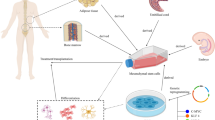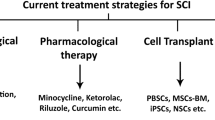Abstract
We investigated the involvement of tPA after SCI in rats and effect of treatment with human umbilical cord blood derived stem cells. tPA expression and activity were determined in vivo after SCI in rats and in vitro in rat embryonic spinal neurons in response to injury with staurosporine, hydrogen peroxide and glutamate. The activity and/or expression of tPA increased after SCI and reached peak levels on day 21 post-SCI. Notably, the tPA mRNA activity was upregulated by 310-fold compared to controls on day 21 post-SCI. As expected, MBP expression is minimal at the time of peak tPA activity and vice versa. Implantation of hUCB after SCI resulted in the downregulation of elevated tPA activity/expression in vivo in rats as well as in vitro in spinal neurons. Our results demonstrated the involvement of tPA in the secondary pathogenesis after SCI as well as the therapeutic potential of hUCB.





Similar content being viewed by others
Abbreviations
- BCA:
-
Bicinchoninic acid
- BDNF:
-
Brain-derived neurotrophic factor
- BSA:
-
Bovine serum albumin
- CNS:
-
Central nervous system
- DAB:
-
Diaminobenzidine
- DAPI:
-
4′,6-Diamidino-2-phenylindole dihydrochloride
- FBS:
-
Fetal bovine serum
- FITC:
-
Fluorescein isothiocyanate
- HRP:
-
Horse radish peroxidase
- hUCB:
-
Human umbilical cord blood derived stem cells
- MBP:
-
Myelin basic protein
- MMP:
-
Matrix metalloproteinase
- NMDA:
-
N-methyl-D-aspartate
- NT-3:
-
Neurotrophic hormone-3
- PAGE:
-
Poly acrylamide gel electrophoresis
- PBS:
-
Phosphate buffered saline
- PCR:
-
Polymerase chain reaction
- PMSF:
-
Phenyl methane sulfonyl fluoride
- SCI:
-
Spinal cord injury
- SDS:
-
Sodium dodecyl sulphate
- STP:
-
Staurosporine
- tPA:
-
Tissue plasminogen activator
References
Collen D (2001) Ham-Wasserman lecture: role of the plasminogen system in fibrin-homeostasis and tissue remodeling. Hematology Am Soc Hematol Educ Program 1–9. doi:10.1182/asheducation-2001.1.1
Collen D (1999) The plasminogen (fibrinolytic) system. Thromb Haemost 82:259–270
Collen D, Lijnen HR (1991) Basic and clinical aspects of fibrinolysis and thrombolysis. Blood 78:3114–3124
Masos T, Miskin R (1997) mRNAs encoding urokinase-type plasminogen activator and plasminogen activator inhibitor-1 are elevated in the mouse brain following kainate-mediated excitation. Brain Res Mol Brain Res 47:157–169. doi:10.1016/S0169-328X(97)00040-5
Salles FJ, Strickland S (2002) Localization and regulation of the tissue plasminogen activator-plasmin system in the hippocampus. J Neurosci 22:2125–2134
Teesalu T, Kulla A, Simisker A et al (2004) Tissue plasminogen activator and neuroserpin are widely expressed in the human central nervous system. Thromb Haemost 92:358–368
Yepes M, Lawrence DA (2004) New functions for an old enzyme: nonhemostatic roles for tissue-type plasminogen activator in the central nervous system. Exp Biol Med (Maywood) 229:1097–1104
Qian Z, Gilbert ME, Colicos MA et al (1993) Tissue-plasminogen activator is induced as an immediate-early gene during seizure, kindling and long-term potentiation. Nature 361:453–457. doi:10.1038/361453a0
Zhuo M, Holtzman DM, Li Y et al (2000) Role of tissue plasminogen activator receptor LRP in hippocampal long-term potentiation. J Neurosci 20:542–549
Shin CY, Kundel M, Wells DG (2004) Rapid, activity-induced increase in tissue plasminogen activator is mediated by metabotropic glutamate receptor-dependent mRNA translation. J Neurosci 24:9425–9433. doi:10.1523/JNEUROSCI.2457-04.2004
Baranes D, Lederfein D, Huang YY et al (1998) Tissue plasminogen activator contributes to the late phase of LTP and to synaptic growth in the hippocampal mossy fiber pathway. Neuron 21:813–825. doi:10.1016/S0896-6273(00)80597-8
Gualandris A, Jones TE, Strickland S et al (1996) Membrane depolarization induces calcium-dependent secretion of tissue plasminogen activator. J Neurosci 16:2220–2225
Parmer RJ, Mahata M, Mahata S et al (1997) Tissue plasminogen activator (t-PA) is targeted to the regulated secretory pathway. Catecholamine storage vesicles as a reservoir for the rapid release of t-PA. J Biol Chem 272:1976–1982. doi:10.1074/jbc.272.3.1976
Pittman RN (1985) Release of plasminogen activator and a calcium-dependent metalloprotease from cultured sympathetic and sensory neurons. Dev Biol 110:91–101. doi:10.1016/0012-1606(85)90067-3
Akassoglou K, Kombrinck KW, Degen JL et al (2000) Tissue plasminogen activator-mediated fibrinolysis protects against axonal degeneration and demyelination after sciatic nerve injury. J Cell Biol 149:1157–1166. doi:10.1083/jcb.149.5.1157
Siconolfi LB, Seeds NW (2001) Induction of the plasminogen activator system accompanies peripheral nerve regeneration after sciatic nerve crush. J Neurosci 21:4336–4347
Siconolfi LB, Seeds NW (2001) Mice lacking tPA, uPA, or plasminogen genes showed delayed functional recovery after sciatic nerve crush. J Neurosci 21:4348–4355
Kim YH, Park JH, Hong SH et al (1999) Nonproteolytic neuroprotection by human recombinant tissue plasminogen activator. Science 284:647–650. doi:10.1126/science.284.5414.647
Cammer W, Bloom BR, Norton WT et al (1978) Degradation of basic protein in myelin by neutral proteases secreted by stimulated macrophages: a possible mechanism of inflammatory demyelination. Proc Natl Acad Sci USA 75:1554–1558. doi:10.1073/pnas.75.3.1554
Rogove AD, Siao C, Keyt B et al (1999) Activation of microglia reveals a non-proteolytic cytokine function for tissue plasminogen activator in the central nervous system. J Cell Sci 112(Pt 22):4007–4016
Tsirka SE, Gualandris A, Amaral DG et al (1995) Excitotoxin-induced neuronal degeneration and seizure are mediated by tissue plasminogen activator. Nature 377:340–344. doi:10.1038/377340a0
Nicole O, Docagne F, Ali C et al (2001) The proteolytic activity of tissue-plasminogen activator enhances NMDA receptor-mediated signaling. Nat Med 7:59–64. doi:10.1038/83358
Cuzner ML, Opdenakker G (1999) Plasminogen activators and matrix metalloproteases, mediators of extracellular proteolysis in inflammatory demyelination of the central nervous system. J Neuroimmunol 94:1–14. doi:10.1016/S0165-5728(98)00241-0
Paterson PY, Koh CS, Kwaan HC (1987) Role of the clotting system in the pathogenesis of neuroimmunologic disease. Fed Proc 46:91–96
Pitt D, Werner P, Raine CS (2000) Glutamate excitotoxicity in a model of multiple sclerosis. Nat Med 6:67–70. doi:10.1038/71555
Smith T, Groom A, Zhu B et al (2000) Autoimmune encephalomyelitis ameliorated by AMPA antagonists. Nat Med 6:62–66. doi:10.1038/71548
Herbert CB, Bittner GD, Hubbell JA (1996) Effects of fibinolysis on neurite growth from dorsal root ganglia cultured in two- and three-dimensional fibrin gels. J Comp Neurol 365:380–391. doi :10.1002/(SICI)1096-9861(19960212)365:3<380::AID-CNE4>3.0.CO;2-0
Uhm JH, Dooley NP, Oh LY et al (1998) Oligodendrocytes utilize a matrix metalloproteinase, MMP-9, to extend processes along an astrocyte extracellular matrix. Glia 22:53–63. doi :10.1002/(SICI)1098-1136(199801)22:1<53::AID-GLIA5>3.0.CO;2-9
Bingham WG, Goldman H, Friedman SJ et al (1975) Blood flow in normal and injured monkey spinal cord. J Neurosurg 43:162–171
Young W, Koreh I (1986) Potassium and calcium changes in injured spinal cords. Brain Res 365:42–53. doi:10.1016/0006-8993(86)90720-1
Faden AI, Simon RP (1988) A potential role for excitotoxins in the pathophysiology of spinal cord injury. Ann Neurol 23:623–626. doi:10.1002/ana.410230618
Wrathall JR, Teng YD, Choiniere D et al (1992) Evidence that local non-NMDA receptors contribute to functional deficits in contusive spinal cord injury. Brain Res 586:140–143. doi:10.1016/0006-8993(92)91384-Q
Milvy P, Kakari S, Campbell JB et al (1973) Paramagnetic species and radical products in cat spinal cord. Ann N Y Acad Sci 222:1102–1111. doi:10.1111/j.1749-6632.1973.tb15327.x
Banik NL, Hogan EL, Powers JM et al (1986) Proteolytic enzymes in experimental spinal cord injury. J Neurol Sci 73:245–256. doi:10.1016/0022-510X(86)90149-8
Balentine JD (1978) Pathology of experimental spinal cord trauma II. Ultrastructure of axons and myelin. Lab Invest 39:254–266
Balentine JD, Hilton C (1980) Ultrastructural pathology of axons and myelin in calcium-induced myelopathy. J Neuropathol Exp Neurol 39:339
Crowe MJ, Bresnahan JC, Shuman SL et al (1997) Apoptosis and delayed degeneration after spinal cord injury in rats and monkeys. Nat Med 3:73–76. doi:10.1038/nm0197-73
Abe Y, Nakamura H, Yoshino O et al (2003) Decreased neural damage after spinal cord injury in tPA-deficient mice. J Neurotrauma 20:43–57. doi:10.1089/08977150360517173
Dasari VR, Spomar DG, Gondi CS et al (2007) Axonal remyelination by cord blood stem cells after spinal cord injury. J Neurotrauma 24:391–410. doi:10.1089/neu.2006.0142
Dasari VR, Spomar DG, Li L et al (2008) Umbilical cord blood stem cell mediated downregulation of Fas improves functional recovery of rats after spinal cord injury. Neurochem Res 33:134–149. doi:10.1007/s11064-007-9426-6
Gruner JA (1992) A monitored contusion model of spinal cord injury in the rat. J Neurotrauma 9:123–126
Ankarcrona M, Dypbukt JM, Bonfoco E et al (1995) Glutamate-induced neuronal death: a succession of necrosis or apoptosis depending on mitochondrial function. Neuron 15:961–973. doi:10.1016/0896-6273(95)90186-8
Andrade-Gordon P, Strickland S (1986) Interaction of heparin with plasminogen activators and plasminogen: effects on the activation of plasminogen. Biochemistry 25:4033–4040. doi:10.1021/bi00362a007
Lu W, Bhasin M, Tsirka SE (2002) Involvement of tissue plasminogen activator in onset and effector phases of experimental allergic encephalomyelitis. J Neurosci 22:10781–10789
Katayama Y, Becker DP, Tamura T et al (1990) Massive increases in extracellular potassium and the indiscriminate release of glutamate following concussive brain injury. J Neurosurg 73:889–900
Lee JM, Grabb MC, Zipfel GJ et al (2000) Brain tissue responses to ischemia. J Clin Invest 106:723–731. doi:10.1172/JCI11003
Choi DW (1987) Ionic dependence of glutamate neurotoxicity. J Neurosci 7:369–379
Osterwalder T, Contartese J, Stoeckli ET et al (1996) Neuroserpin, an axonally secreted serine protease inhibitor. EMBO J 15:2944–2953
Akenami F, Sirén V, Koskiniemi M et al (1996) Cerebrospinal fluid activity of tissue plasminogen activator in patients with neurological diseases. J Clin Pathol 49:577–580
Cuzner M, Gveric D, Strand C et al (1996) The expression of tissue-type plasminogen activator, matrix metalloproteases and endogenous inhibitors in the central nervous system in multiple sclerosis: comparison of stages in lesion evolution. J Neuropathol Exp Neurol 55:1194–1204
Acknowledgments
This research was supported by a grant from the Illinois Regenerative Medicine Institute, a program of the Illinois Department of Public Health, through funds available from the Illinois Department of Healthcare and Family Services. We thank Peggy Mankin and Noorjehan Ali for technical assistance. We thank Shellee Abraham for manuscript preparation and Diana Meister and Sushma Jasti for manuscript review.
Author information
Authors and Affiliations
Corresponding author
Rights and permissions
About this article
Cite this article
Veeravalli, K.K., Dasari, V.R., Tsung, A.J. et al. Stem Cells Downregulate the Elevated Levels of Tissue Plasminogen Activator in Rats After Spinal Cord Injury. Neurochem Res 34, 1183–1194 (2009). https://doi.org/10.1007/s11064-008-9894-3
Accepted:
Published:
Issue Date:
DOI: https://doi.org/10.1007/s11064-008-9894-3




